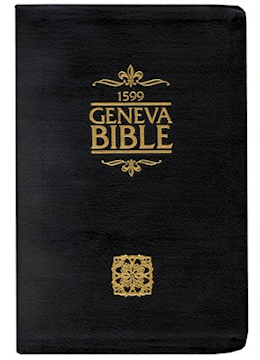Textus Receptus Bibles
Geneva Bible 1560/1599
| 2:1 | I am the rose of the fielde, and the lilie of the valleys. |
| 2:2 | Like a lilie amog the thornes, so is my loue among the daughters. |
| 2:3 | Like the apple tree among the trees of the forest, so is my welbeloued among the sonnes of men: vnder his shadow had I delite, and sate downe: and his fruite was sweete vnto my mouth. |
| 2:4 | Hee brought mee into the wine cellar, and loue was his banner ouer me. |
| 2:5 | Stay me with flagons, and comfort me with apples: for I am sicke of loue. |
| 2:6 | His left hande is vnder mine head, and his right hand doeth imbrace me. |
| 2:7 | I charge you, O daughters of Ierusalem, by the roes and by the hindes of the fielde, that ye stirre not vp, nor waken my loue, vntill she please. |
| 2:8 | It is the voyce of my welbeloued: beholde, hee commeth leaping by the mountaines, and skipping by the hilles. |
| 2:9 | My welbeloued is like a roe, or a yong hart: loe, he standeth behinde our wall, looking forth of the windowes, shewing him selfe through the grates. |
| 2:10 | My welbeloued spake and said vnto me, Arise, my loue, my faire one, and come thy way. |
| 2:11 | For beholde, winter is past: the raine is changed, and is gone away. |
| 2:12 | The flowers appeare in the earth: the time of the singing of birdes is come, and the voyce of the turtle is heard in our land. |
| 2:13 | The figtree hath brought foorth her yong figges: and the vines with their small grapes haue cast a sauour: arise my loue, my faire one, and come away. |
| 2:14 | My doue, that art in the holes of ye rocke, in the secret places of the staires, shewe mee thy sight, let mee heare thy voyce: for thy voyce is sweete, and thy sight comely. |
| 2:15 | Take vs the foxes, the little foxes, which destroy the vines: for our vines haue small grapes. |
| 2:16 | My welbeloued is mine, and I am his: hee feedeth among the lilies, |
| 2:17 | Vntil the day breake, and the shadowes flee away: returne, my welbeloued, and be like a roe, or a yong hart vpon the mountaines of Bether. |

Geneva Bible 1560/1599
The Geneva Bible is one of the most influential and historically significant translations of the Bible into English, preceding the King James translation by 51 years. It was the primary Bible of 16th century Protestantism and was the Bible used by William Shakespeare, Oliver Cromwell, John Knox, John Donne, and John Bunyan. The language of the Geneva Bible was more forceful and vigorous and because of this, most readers strongly preferred this version at the time.
The Geneva Bible was produced by a group of English scholars who, fleeing from the reign of Queen Mary, had found refuge in Switzerland. During the reign of Queen Mary, no Bibles were printed in England, the English Bible was no longer used in churches and English Bibles already in churches were removed and burned. Mary was determined to return Britain to Roman Catholicism.
The first English Protestant to die during Mary's turbulent reign was John Rogers in 1555, who had been the editor of the Matthews Bible. At this time, hundreds of Protestants left England and headed for Geneva, a city which under the leadership of Calvin, had become the intellectual and spiritual capital of European Protestants.
One of these exiles was William Whittingham, a fellow of Christ Church at Oxford University, who had been a diplomat, a courtier, was much traveled and skilled in many languages including Greek and Hebrew. He eventually succeeded John Knox as the minister of the English congregation in Geneva. Whittingham went on to publish the 1560 Geneva Bible.
This version is significant because, it came with a variety of scriptural study guides and aids, which included verse citations that allow the reader to cross-reference one verse with numerous relevant verses in the rest of the Bible, introductions to each book of the Bible that acted to summarize all of the material that each book would cover, maps, tables, woodcut illustrations, indices, as well as other included features, all of which would eventually lead to the reputation of the Geneva Bible as history's very first study Bible.